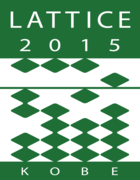Speaker
Dr
Thorsten Kurth
(Lawrence Berkeley National Laboratory)
Description
The electroweak interaction on the level of quarks and gluons are well understood from precision measurements in high energy collider experiments.
Relating these fundamental parameters to Hadronic Parity Violation in nuclei however remains an outstanding theoretical challenge. One of the most interesting observables in this respect is the parity violating hadronic neutral current: it is hard to measure in collider experiments and is thus the least constrained observable of the Standard Model.
Precision measurements of parity violating transitions in nuclei can help to improve these constraints.
In these systems however, the weak interaction is masked by effects of the ~7 orders of magnitude stronger non-perturbative strong interaction.
Therefore, in order to relate experimental measurements of the parity violating pion-nucleon couplings to the fundamental Lagrangian of the SM, these non-perturbative effects have to be well understood. In this talk, I am going to present a Lattice QCD approach for computing the $\Delta I=2$ parity violating matrix element in proton proton scattering.
This process does not involve disconnected diagrams in the isospin symmetric limit and is thus a perfect testbed for studying the feasibility of the more involved calculation of the parity violating pion-nucleon coupling. In this talk, I am going to present our technology for computing this quantity and some preliminary results.
Primary author
Dr
Thorsten Kurth
(Lawrence Berkeley National Laboratory)
Co-authors
Dr
Amy Nicholson
(UC Berkeley)
Dr
Evan Berkowitz
(Lawrence Livermore National Laboratory)
Mr
Mark Strother
(UC Berkeley)
Dr
Pavlos Vranas
(Lawrence Livermore National Laboratory)
Dr
Raul Briceno
(Thomas Jefferson National Accelerator Facility)

